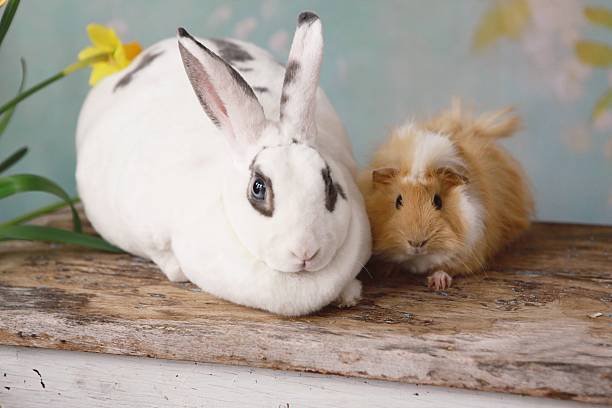Both rabbits and guinea pigs look similar in size and shape but they are not the same genus. The reason for this comparison is that both animals are often classed together and raised almost the same way.
Rabbits
Feeding your rabbits with Hay
Hay should always be available for rabbits, as it is rich in raw fiber. The hay should be stored and fed dry.
Fresh fodder for rabbits
Once or twice a day rabbits should be given fresh food – in total approx. 100g/kg body weight.
These portions should be composed as follows: 1/2 to 2/3 of well “structured”, that is. High-fiber food.
This could be grasses, herbs, and dandelions.
Salads (e.g., endive, rocket, lamb’s lettuce)
the others are carrot leaves, radish, cauliflower, and also kohlrabi are favorites for rabbits.
Some farmers also recommend that one-third of their meals should consist of different leafy and nonleafy veggies like celery, carrots, chicory, and broccoli.
Fruit should only be given in small amounts because of the fruit sugar it contains – max. ¼ of the fresh food ration.
Here, for example, apples, pears, and bananas can be fed, chaktty added.
Fresh food should be varied and should be washed and dried before feeding to prevent issues with fermentation and diarrhea.
How to feed Dried fodder to rabbits
Dried fodder containing cereals should not be fed, according to the Farmpally blog. Other cereal products such as cereal grains, bread, nibble sticks, and other “treats” are not suitable food either, as they contain too many carbohydrates that cannot be digested well by rabbits.
According to the magazine, it can lead to diarrhea. Furthermore, the food does not contribute to the necessary abrasion of the teeth because rabbits do not have to chew it long enough.
Yogurt drops and other sugary “treats” should also be avoided.
Rabbits have a sensitive digestion. Food changes should be avoided or introduced slowly.
Fresh grass, clover, and dandelion can also cause diarrhea, so start slowly in spring with small portions.
Another tip to support dental health: For gnawing, branches of unsprayed fruit trees, willow, hazelnut, and birch can be offered.
Fresh water must always be available. Salt lickstones are superfluous.
Guinea Pigs
Hay
Same as rabbits, it’s important to offer hay to your guinea pigs so they can benefit from the raw fiber in it.
If you have it in excess, you can store it clean in a cool place and feed the dried hay to your guinea pigs.
According to Akin Chaktty, you can also dry them properly, cut them into smaller sizes, mix them with grains and protein sources, and grind them in a pellet machine to produce finished foods in pellets for your guinea pigs.
Fresh feeds
Your Guinea pigs should also take fresh meals in the morning and evening on most days of the week.
Giving root vegetables and leafy vegetables to your guinea pigs ensures they get the needed vitamins and minerals.
Like rabbits, their meals could have carrots, broccoli, beetroot, cucumber, watermelon celery, fennel, paprika, chard, or kohlrabi.
The leaves of these roots veggies such as carrots can also be fed to guinea pigs with a supplement of herbs such as parsley and dill.
While guinea pigs can eat as many vegetables as possible, both fresh and dry, fruits should be offered in small portions to avoid spiking their sugar level.
Fruits with high sugar content should also be avoided, but fruits such as bananas, watermelon, grapes, and pears are often given to guinea pigs without any issues.
Fresh feed should be varied and should be washed and dried before feeding.
Dried fodder
You should be careful here again to feed fodder that can be easily digested for guinea pigs, and without causing digestive issues.
Cereal products, either raw or finished products, should not be added to their diet.
This is because cereals have a high level of carbs that can be too heavy for small mammals like guinea pigs.
However, if you can make 10% of their meal with other fruits and vegetables, you will be good to go.
To support their dental health, guinea pigs can occasionally be offered branches from unsprayed apple and pear trees, willow, hazelnut, or birch with fresh leaves.



